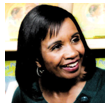Girls of Color and STEM: A Personal Story
From Irene Smalls
 This story is true, but it is based on a lie. I was afraid of math. A female teacher in elementary school told me that I couldn’t do math. That message stayed in my head for most of my life. Indeed, a paper published in the January 2010 issue of the Proceedings of the National Academy of Sciences suggest that “having a highly math-anxious female teacher may push girls to confirm the stereotype they are not as good as boys in math, which in turn, affects girls‘ math achievement.” Being a female of color, that message had a double impact. The academic achievement gap between children of color and whites in this country is well known and believed among children as well as adults. This story is true, but it is based on a lie. I was afraid of math. A female teacher in elementary school told me that I couldn’t do math. That message stayed in my head for most of my life. Indeed, a paper published in the January 2010 issue of the Proceedings of the National Academy of Sciences suggest that “having a highly math-anxious female teacher may push girls to confirm the stereotype they are not as good as boys in math, which in turn, affects girls‘ math achievement.” Being a female of color, that message had a double impact. The academic achievement gap between children of color and whites in this country is well known and believed among children as well as adults.
The moment in school I could stop taking math I did. According to a recent study, the percentage of girls who say they would not study math anymore given a choice increases from 9% in fourth grade to 15% in eighth grade to 50% in twelfth grade. I was one of those girls. I did not take a single math course in college at Cornell University. My fear of math had an after-affect. Though I loved science, I stayed away from science too.
Graduating from college, I had to find a career. All the women I knew were social workers or teachers. I did not know any Black women in STEM. I knew one Black woman in business. Generation STEM, a 2012 Girl Scouts of America study, concluded that African-American and Hispanic girls have fewer supports and less exposure to STEM careers. The Black female in business made more money than the teachers and the social workers. I applied to business school. The Girl Scout report also found African-American (41%) and Hispanic girls (31%) are more likely to be motivated to choose a career that pays a lot of money compared to Caucasian girls (21%).
Graduating from Business School, I embarked on a career in corporate America in marketing. After ten years, with marketing becoming increasingly more quantitative, I decided to change careers. I jumped into the depths of anti-math. I became an artist, a licensed hairstylist, a model, a beauty queen, a fashionista and a writer/storyteller. I published 15 children’s books with Little Brown, Simon and Schuster and Scholastic. I produced three storytelling CDs. Twice I was invited to the White House in Washington, DC to perform my stories. I could create. I could be pretty. I could dress. I could talk, I could write. But I couldn’t do math.
I firmly believed I couldn’t do math until I read an article about math and hair by a Black female mathematician, Dr. Gloria Gilmer. Her article entitled, “Mathematical Patterns in African-American Hairstyles,” was an eye-opening experience. I had been using algorithms to braid fractal hairstyles my whole life. I fell in love...hard... with math of all things and advanced mathematics, fractal geometry, at that. With my predilection for fashion, I had an epiphany. Hair plus Math = HairMath. Being a hairstylist, I realized girls do math and science every day styling their hair. Girls have a head for math. A study published in the British Journal of Educational Psychology in 2011 discovered “Female Topics Encourage Girls to Study Science.” I created HairMath for girls like me who don’t have the confidence or support to explore science and math. Pythagoras and Euclid with the Golden Ratio proved it is math that makes you beautiful!
Five years ago cleaning out some old papers, I found my college SAT scores. I started to cry. My math score was much higher than my verbal score. I had seen my SAT scores many times applying to colleges as a high schooler. But, my overpowering self-belief that I could not do math did not allow my actual math scores to register in my brain. My lifetime fear of math was a lie. I am good in math.
Irene Smalls, MBA, and Director of the Power in Play, non-profit, is the creator of HairMath an informal learning tool that engages math adverse girls of color with STEM. She will write more about HairMath in a future issue of STEM Pals.
Back to newsletter |